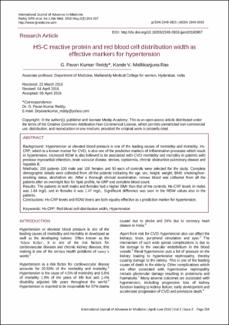| dc.creator | Kumar Reddy, G. Pava | |
| dc.creator | Mallikarjuna Rao, Kande V. | |
| dc.date.accessioned | 2020-02-10T15:21:09Z | |
| dc.date.available | 2020-02-10T15:21:09Z | |
| dc.date.issued | 2016-04-06 | |
| dc.identifier.issn | 2349-3933 | |
| dc.identifier.uri | http://repositorio-indicasat.org.pa/handle/123456789/15 | |
| dc.description | Background: Hypertension or elevated blood pressure is one of the leading causes of morbidity and mortality. HsCRP, which is a known marker for CVD, is also one of the predictive markers of inflammation processes which result in hypertension. Increased RDW is also believed to be associated with CVD morbidity and mortality in patients with previous myocardial infarction, brain vascular disease, strokes, septicemia, chronic obstructive pulmonary disease and hepatitis B. Methods: 200 patients 100 male and 100 females and 50 each of controls were selected for the study. Complete demographic details were collected from all the patients including the age, sex, height, weight, BMI, smoking/nonsmoking status, alcoholism etc. After a thorough clinical examination, venous blood was collected from all the patients after an overnight fast for lipid profile, hs-CRP and complete blood count. Results: The patients in both males and females had a higher BMI than that of the controls. Hs-CRP levels in males was 1.64 mg/L and in females it was 1.47 mg/L. Significant difference was seen in the RDW values also in the patients. Conclusions: Hs-CRP levels and RDW levels are both equally effective as a predictive marker for hypertension. | en_US |
| dc.description.abstract | Background: Hypertension or elevated blood pressure is one of the leading causes of morbidity and mortality. HsCRP, which is a known marker for CVD, is also one of the predictive markers of inflammation processes which result in hypertension. Increased RDW is also believed to be associated with CVD morbidity and mortality in patients with previous myocardial infarction, brain vascular disease, strokes, septicemia, chronic obstructive pulmonary disease and hepatitis B. Methods: 200 patients 100 male and 100 females and 50 each of controls were selected for the study. Complete demographic details were collected from all the patients including the age, sex, height, weight, BMI, smoking/nonsmoking status, alcoholism etc. After a thorough clinical examination, venous blood was collected from all the patients after an overnight fast for lipid profile, hs-CRP and complete blood count. Results: The patients in both males and females had a higher BMI than that of the controls. Hs-CRP levels in males was 1.64 mg/L and in females it was 1.47 mg/L. Significant difference was seen in the RDW values also in the patients. Conclusions: Hs-CRP levels and RDW levels are both equally effective as a predictive marker for hypertension. | en_US |
| dc.format | application/pdf | |
| dc.language.iso | eng | en_US |
| dc.publisher | International Journal of Advances in Medicine | en_US |
| dc.rights | info:eu-repo/semantics/openAccess | |
| dc.rights | https://creativecommons.org/licenses/by-nc-nd/4.0/ | |
| dc.subject | Hs-CRP | en_US |
| dc.subject | Red blood cell distribution width | en_US |
| dc.subject | Hypertension | en_US |
| dc.title | HS-C reactive protein and red blood cell distribution width as effective markers for hypertension | en_US |
| dc.type | info:eu-repo/semantics/article | |
| dc.type | info:eu-repo/semantics/publishedVersion | |

